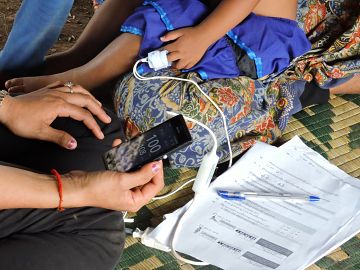New research shows handheld pulse oximeters are suitable tools for frontline health workers in detecting severe illness in children under five in resource-poor countries
25 July 2021 Photo credit Peter Caton
Photo credit Peter CatonFrontline health workers who tested five different pulse oximeters to detect blood oxygen saturation in children under five at district hospitals in low resource hospitals, found that handheld oximeters are easy to use and a reliable, live-saving tool to detect pneumonia. Findings of the Malaria Consortium-led study suggests that these types of pulse oximeters should be made widely available to frontline health workers in low-resource countries. The study results were published in EClinicalMedicine.
Pulse oximeters can detect low blood oxygen saturation (SpO2), or hypoxaemia, an indicator of severe illness in children which can be fatal. They are a globally accepted, easy to use tool to identify severe illness, but are rarely available in resource-constrained countries. Malaria Consortium feels that the inclusion of pulse oximetry in the management of severe illness in resource-poor settings is required to stop the preventable deaths of many children.
“Now that we have shown that frontline health workers can use pulse oximeters, we need to focus on how this can be translated to best address COVID-19 as well as other severe illness – all frontline health workers should have these essential tools available to them,” said Kevin Baker, Research Advisor at Malaria Consortium and lead researcher of the study.
In this first large-scale study the researchers wanted to identify the most accurate, acceptable, scalable and user-friendly pulse oximeters for frontline health workers to detect hypoxaemia in children under five. The study took place in Cambodia, Ethiopia, South Sudan and Uganda, with 207 frontline health workers evaluating the devices’ performance. Five devices were tested: two fingertip pulse oximeters, two handheld pulse oximeters and one phone pulse oximeter. All devices are readily available on the market with costs ranging from 40 USD up to 250 USD.
Most health workers were able to use the devices to record a SpO2 measurement and the failure rate after three attempts was just 4.5 percent. The Masimo mobile phone pulse oximeter had the best overall performance across both primary and secondary outcome measures. Handheld pulse oximeters, Lifebox and Utech, with multiple probes to fit different ages of children, performed better than fingertip pulse oximeters. Fingertip devices, Contec and Devon were more likely to underestimate SpO2 and are therefore not recommended for use by frontline healthcare workers for children under five.
In 2014, the World Health Organization amended guidelines on facility-based management of pneumonia to include the use of pulse oximetry, when these devices are available. Supported by these findings and based on the experience of health workers using the tools as part of the study, Malaria Consortium is urging donors and governments to support the wider use of pulse oximeters as an effective tool to detect severe illness.
Malaria Consortium is a member of the Every Breath Counts Coalition, the world’s first public-private partnership to support national governments to end pneumonia deaths by 2030.
Keywords: Research
Latest news
- Malaria Consortium honoured by Ugandan government for contribution to combat malaria23rd April 2024
- International summit calls for AMR accountability in public health interventions21st March 2024
- Global SMC community celebrates new milestone at SMC Alliance Annual Meeting in Nigeria6th March 2024
- Scaling up key interventions could halve pneumonia-related childhood mortality13th February 2024
- Malaria Consortium and eGov Foundation join Mozambique’s national malaria programme to digitalise seasonal malaria chemoprevention campaigns8th February 2024
- World’s first malaria vaccine rollout launched in Cameroon22nd January 2024